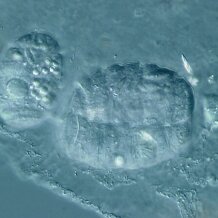Topic: Dinoflagellate "nematocysts"
Categories: Anatomy, Cnidarians, Feeding, Plants & Algae, Protistans
Examples of convergence within the dinoflagellates range from the evolution of a camera-like eye to stinging 'nematocysts' reminiscent of those in jellyfish.
In the context of convergent evolution dinoflagellates are highly instructive, with examples within the group ranging from the evolution of a camera-like eye, parasitism (both ecto- and endoparasitism), production of the potentially lethal toxin known as saxitoxin, and even a convergence with ciliates in the sediment-dwelling Stephanopogon.  Here we consider the evolution of stinging threads, convergent on the nematocysts of cnidarians, in two groups of dinoflagellates.
Here we consider the evolution of stinging threads, convergent on the nematocysts of cnidarians, in two groups of dinoflagellates.
Many dinoflagellates are active swimmers in the water column, not as zooplakton but as phytoplankton, being photosynthetic and derived from algae. Some, however, have lost their chloroplasts and so become heterotrophic rather than photosynthetic. These include the group known as the polykrikids, which are evidently related to the warnowiids (famous for their eyes). In both polykridids and warnowiids a nematocyst has evolved, representing another remarkable example of convergence.
 Nematocysts, of course, characterize the cnidarians and are the source of the stinging inflicted by jellyfish, which in groups such as the cubozoans can have fatal consequences. The nematocyst operates by very rapidly everting a thread-like structure, often barbed, that delivers venom. The nematocyst is a single cell, but in the dinoflagellates a very similar structure is derived from an organelle (as is the eye). In addition in some of these dinoflagellates there is an accompanying structure, known as the taeniocyst (again derived from an organelle). Whilst the similarity of dinoflagellate and cnidarian nematocysts has long been appreciated, and correspondingly the assumption that in the latter group they are involved with capture of prey, only recently has this been confirmed.
Nematocysts, of course, characterize the cnidarians and are the source of the stinging inflicted by jellyfish, which in groups such as the cubozoans can have fatal consequences. The nematocyst operates by very rapidly everting a thread-like structure, often barbed, that delivers venom. The nematocyst is a single cell, but in the dinoflagellates a very similar structure is derived from an organelle (as is the eye). In addition in some of these dinoflagellates there is an accompanying structure, known as the taeniocyst (again derived from an organelle). Whilst the similarity of dinoflagellate and cnidarian nematocysts has long been appreciated, and correspondingly the assumption that in the latter group they are involved with capture of prey, only recently has this been confirmed.
In passing we should also note that the polykrikid dinflagellates can show an intriguing pseudo-coloniality, and not only does this have some similarities to the parasitic dinoflagellate Haplozoon, but has itself evidently evolved several times independently.
Cite this web page
Map of Life - "Dinoflagellate "nematocysts""
https://mapoflife.org/topics/topic_356_Dinoflagellate-nematocysts/
September 27, 2015
(Topic created 12th February 2009) | Last modified: 2nd November 2009
Please note: words or phrases shown in bold in the PRINT VERSION of this text normally indicate hyperlinks on the webpage. These generally return a list of search results based on that keyword.